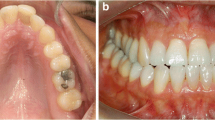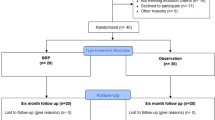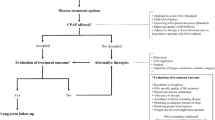Abstract
Prior small and retrospective studies have indicated that obstructive sleep apnea (OSA) disease-related psychiatric morbidity might be reversed by correcting the sleep-related breathing disorder.
To evaluate the effect of surgical intervention (uvulopalatopharyngoplasty, UPPP) on associated psychiatric morbidity we prospectively evaluated a large cohort (n = 53) of OSA patients before and after UPPP.
Surgical intervention resulted in a significant reduction of depressive disorder (p < .001) in parallel with improvement of the sleep disorder. Our results show that sleep disturbance and reduced daytime alertness may be at least one of the factors behind depressive symptoms in OSA.
Similar content being viewed by others
References
American Psychiatric Association committee on Nomenclature and Statistics. (1987). Diagnostic and statistical manual of mental disorders (DSM-III-R; 3rd ed). Washington, DC: Author.
Åsberg, M., Perris, C., Schalling. D., & Sedvall, G. (1978). The CPRS-development and applications of a psychiatric rating scale. Acta Psychiatrica Scandinavica, supplement 271, 1–27.
Borak, J., Cieslicki, J. K., Koziej, M., Matuszewski, A., & Zielinski, J. (1996). Effects of CPAP treatment on psychological status in patients with severe obstructive sleep apnoea. Journal of Sleep Research, 5, 123–127.
Carlson, J., Davies, R., & Ehlenz, K. (1993). Obstructive sleep apnea and blood pressure elevation: What is the relationship? Blood Pressure, 2, 166–182.
Carroll, B. J. (1985). Dexamethasone suppression test: A review of contemporary confusion. Journal of Clinical Psychiatry, 46, 13–24.
Carroll, B. J., Feinberg, M., Greden, J. F., Tarika, J., Albala, A. A., Haskett, R. F., James, N. M., Kronfol, Z., Lohr, N., Steiner, M., de Vigne, J. P., & Young, E. (1981). A specific laboratory test for the diagnosis of melancholia: Standardization, validation and clinical utility. Archives of General Psychiatry, 38, 15–22.
Cooper, B. G., Griffiths, C. J., & Gibson, G. (1991). Value of nocturnal oxygen saturation as a screening test for sleep apnea. Thorax, 46, 586–588.
Dash, R. J., England, B. J., Midgley, A. R., Jr., & Niswender, G. D. (1975). A specific non-chromatographic radioimmunoassay for human plasma cortisol. Steroids, 26, 647–681.
Douglas, N., Thomas, F., & Jan, M. (1992). Clinical value of polysomnography. Lancet, 339, 347–350.
Ejnell, H., Björkman, R., Wåhlander, L., & Hedner, J. (1992). Treatment of postoperative pain with diclofenac in uvulopalatopharyngoplasty. British Journal of Anaesthesia, 68, 76–80.
Findley, L. J., Barth, J. T., Powers, D. C., Wilhoit, S. C., Boyd, D. G., & Suratt, P. M. (1986). Cognitive impairment in patients with obstructive sleep apnea and associated hypoxemia. Chest, 90, 686–690.
Fujita, S. (1987). Pharyngeal surgery for obstructive sleep apnea and snoring. In Fairbanks et al. (Eds.), Snoring and obstructive sleep apnea (pp. 101–128). New York: Raven.
Gislason, T., Almqusit, M., Eriksson, G., Taube, A., & Boman, G. (1988). Prevalence of sleep apnea among Swedish men. Journal of Clinical Epidemiology, 41, 571–576.
Guilleminault, C., Eldridge, F. L., Tilkian, A., Simmons, F. B., & Dement, W. C. (1977). Sleep apnea syndrome due to upper airway obstruction. Archives of Internal Medicine, 137, 296–300.
Hedner, J., Ejnell, H., & Caidahl, K. (1990). Left ventricular hypertrophy independent of hypertension in patients with obstructive sleep apnea. Journal of Hypertension, 8, 941–946.
Kales, A., Cadieux, R. J., Bixler, E. O., Soldatos, C. R., Vela-Bueno, A., Misoul, C. A., & Locke, T. W. (1985). Severe obstructive sleep apnea. I: Onset, clinical course and characteristics. Journal of Chronic Disease, 38, 419–425.
Klonoff, H., Fleetham, J., Taylor, D. R., & Clark, C. (1987). Treatment outcome of obstructive sleep apnea. Physiological and neuropsychological concomitants. Journal of Nervous and Mental Disease, 175, 208–212.
Kuhlo, W., Doll, E., & Frank, M. D. (1969). Erfolgreiche Behandlung eines Pickwick-Syndroms durch eine davertracheal Kanüle. Deutsche medizinische Wochenschrift, 94, 1286–1290.
Lantto, O., Lindbäck, B., Aakvaag, A., Damkjaer-Nielsen, M., Pomoell, U. M., & Bjorkhem, I. (1983). Assay of cortisol with a radioimmunoassay method calibrated by isotopic dilutionmass spectrometry. A Nordic collaborative study. Scandinavian Journal of Clinical and Laboratory Investigation, 43, 433–437.
Larsson, H., Carlsson-Nordlander, B., & Svanborg, E. (1991). Long-time follow-up after UPPP for obstructive sleep-apnea syndrome. Result of sleep apnea recordings and subjective evaluation 6 months and 2 years after surgery. Acta Oto-Laryngologica, 1, 582–590.
Lavie, P. (1983). Incidence of sleep apnea in presumably healthy working population. Sleep, 6, 312–318.
Lugaresi, E., Cirignotta, F., Coccagna, G., & Piana, C. (1980). Some epidemiological data on snoring and cardio-circulatory disturbances. Sleep, 3, 221–224.
Millman, R., Fogel, B. S., McNamara, M.-E., & Carlisle, C. C. (1989). Depression as a manifestation of obstructive sleep apnea. Reversal with nasal continuous positive airway pressure. Journal of Clinical Psychiatry, 50, 348–351.
Mosko, S., Zetin, M., Glen, S., Garber, D., DeAntonio, M., Sassin, J., McAnich, J., & Warren, S. (1989). Self-reported depressive symptomatology, mood ratings and treatment outcome in sleep disorder patients. Journal of Clinical Psychology, 45, 51–60.
Reynolds, C. F., Kupfer, D. J., McEachran, A. B., Taska, L. S., Sewitch, D. E., & Cable, P. A. (1984). Depressive psychopathology in male sleep. Journal of Clinical Psychiatry, 45, 287–290.
Shepard, J. W., Jr. (1992). Hypertension, cardiac arrhythmias, myocardial infarction and stroke in relation to obstructive sleep apnea. Clinical Chest Medicine, 13, 437–458.
Spitzer, R., Williams, J. B., Gibbon, M., & First, M. B. (1989). Instruction manual for the Structured Clinical Interview for DSM-III-R (SCID 5/1/89 revision). New York: Biometrics Research Department, New York State Psychiatric Institute.
Tilkian, A., Guilleminault, C., Schroeder, J. S., Lehrman, K. L., Simmons, F. B., & Dement, W. C. (1976). Hemodynamics in sleep induced apnea, studies during wakefulness and sleep. Annals of Internal Medicine, 85, 714–719.
Weissman, M. M., Leaf, P. J., Tischler, G. L., Blazer, D. G., Karno, M., Bruce, M. L., & Florio, L. P. (1988). Affective disorders in five United States communities. Psychological Medicine, 18, 141–153.
Young, T., Palta, M., Dempsey, J., Skatrud, J., Weber, S., & Baadr, S. (1993). Sleep disordered breathing among middle-aged adults. New England Journal of Medicine, 328, 1230–1235.
Author information
Authors and Affiliations
Additional information
This study was supported by grants from the Swedish Medical Research Council (Grant No. 9892), the Swedish Heart and Lung Foundation, Inga-Britt and Arne Lundbergs Research Foundation, Skandia Insurance Company, The Swedish Medical Society, and Gothenburg University Research Foundation.
Nils-Gunnar Pehrsson and Andreas Hagelin are gratefully acknowledged for skillful statistical assistance.
Rights and permissions
About this article
Cite this article
Dahlöf, P., Ejnell, H., Hällström, T. et al. Surgical treatment of the sleep apnea syndrome reduces associated major depression. Int. J. Behav. Med. 7, 73–88 (2000). https://doi.org/10.1207/S15327558IJBM0701_6
Issue Date:
DOI: https://doi.org/10.1207/S15327558IJBM0701_6




